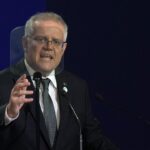Supply chain snags cause financial contraction despite restriction ease
Japan’s economy contracted much faster than expected in the third quarter as global supply disruptions hit exports and business spending plans and fresh COVID-19 cases soured the consumer mood.
While many analysts expect the world’s third-largest economy to rebound in the current quarter as virus curbs ease, worsening global production bottlenecks pose increasing risks to export-reliant Japan.
“The contraction was far bigger than expected due to supply-chain constraints, which hit car output and capital spending hard,” said Takeshi Minami, chief economist at Norinchukin Research Institute.
“We expect the economy to stage a rebound this quarter but the pace of recovery will be slow as consumption did not get off to a good start even after COVID-19 curbs were eased late in September.”
The economy shrank an annualized 3 percent in July-September after a revised 1.5 percent gain in the first quarter, preliminary gross domestic product (GDP) data showed on Monday, much worse than a median market forecast for a 0.8 percent contraction.
The weak GDP contrasts with more promising readings from other advanced nations such as the US, where the economy expanded 2 percent in the third quarter on strong pent-up demand.
Some analysts said Japan’s heavy dependency on the auto industry meant the economy was more vulnerable to trade disruptions than other countries.
Shinichiro Kobayashi, principal economist at Mitsubishi UFJ Research and Consulting, said automakers make up a large part of Japan’s manufacturing sector with a wide range of subcontractors directly affected.
Prime Minister Fumio Kishida plans to compile a large-scale economic stimulus package worth “several tens of trillion yen” on Friday, but some economists were skeptical about its impact on growth near-term.
“The package will likely be a mixed bag of near-term and long-term growth measures, and the focus may be blurred, so it won’t have much impact near-term,” Norinchukin’s Minami said.
Consumption fell 1.1 percent in July-September from the previous quarter after a 0.9 pecent gain in April-June.
Capital expenditure also decreased 3.8 percent after rising from a revised 2.2 percent in the previous quarter. Domestic demand shaved off 0.9 percent point to GDP growth.
Exports lost 2.1 percent in July-September from the previous quarter as trade was hurt by chip shortages and supply-chain constraints.
Analysts polled by Reuters expect Japan’s economy to expand an annualized 5.1 percent in the current quarter, as consumer activity and auto output pick up.
However, Japanese firms still face risks from higher commodity costs and supply bottlenecks, which threaten to undermine the economic outlook over the short- to mid-term.
Real GDP, which factors in the effects of inflation, won’t return to pre-pandemic levels until the second half of 2023, said Takahide Kiuchi, a former Bank of Japan board member who now serves as chief economist at Nomura Research Institute.
Reuters / Global Times



